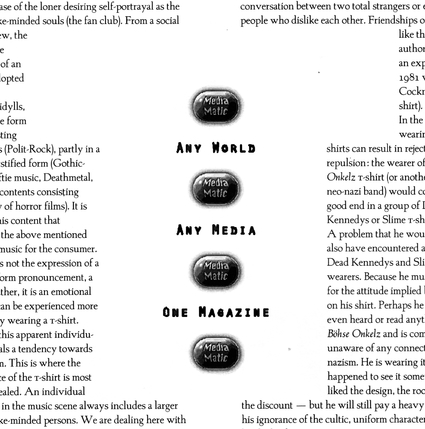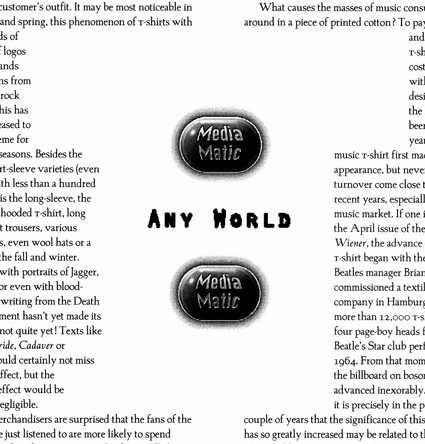One of the genres of this cotton textile article that still has the official status of 'leisure clothing' is the band shirt. The music business has recently expanded its activities beyond the production of records and cd's to include the customer's outfit. It may be most noticeable in the summer and spring, this phenomenon of t-shirts with the thousands of variations of logos of various bands and musicians from the pop and rock world. But this has long since ceased to be only a theme for the warmer seasons. Besides the classical short-sleeve varieties (even for bands with less than a hundred fans!), there is the long-sleeve, the sweater, the hooded t-shirt, long and/or short trousers, various kinds of caps, even wool hats or a raincoat for the fall and winter. Underwear with portraits of Jagger, Sting & co. or even with blood-soaked handwriting from the Death Metal movement hasn't yet made its appearance, not quite yet! Texts like My Dying Bride, Cadaver or Painkiller would certainly not miss their erotic effect, but the advertising effect would be practically negligible.
Article of Consumption and Advertising Factor
Many merchandisers are surprised that the fans of the band they've just listened to are more likely to spend money on a t-shirt than a cd, except for the so-called great bands that leave the trade to professional enterprises in which no-one is surprised at anything anymore. The fourteen-year-old boy squandering his last savings has become a familiar sight to the hawker at the ac/dc booth. In the smaller bands, in which the bus is usually driven by an acquaintance or a friend who also mans the folding table after the show, the number of t-shirts sold in comparison to cd's is still amazing. A cd can be copied x number of times among one's circle of acquaintances; the shirt can certainly never be copied. In this way, it has come to mean a great deal compared to the cd. The cd as a reproducible mass product, the band shirt as an individual possession.
There are bands that sell more printed cotton than cd's or records. Two examples: almost everyone knows the Asshole Shirts of the Rock'n Country band Cliff Barnes and The Fear of Winning. But their music is unknown to many. The same thing occurred with Angefahrene Schulkindern who owe their break into the glossy pages of German periodicals, as well as a television series, to the success of their Tötet Onkel Dittmeyer Shirts. Of course, the charges brought by the above mentioned fruit juice company provided the necessary media hubbub and corresponding boom in shirt sales. But today, does the name Angefahrene Schulkindern mean the band, their art, their music? No, most people know them only as the producers of a certain t-shirt, like Cliff Barnes. However much of a sense of humor you have, this can never have been the band's original motivation – Cliff Barnes and the Fear of Winning have already broken up.
What causes the masses of music consumers to walk around in a piece of printed cotton? To pay between £10 and £18.50 for a t-shirt that would cost about two without a printed design: what is the fun of it? It's been about thirty years since the music t-shirt first made its appearance, but never has the turnover come close to that of recent years, especially on the music market. If one is the believe the April issue of the periodical Wiener, the advance of the music t-shirt began with the Beatles. Beatles manager Brian Epstein commissioned a textile printing company in Hamburg to make more than 12,000 t-shirts with the four page-boy heads from the Beatle's Star club performance of 1964. From that moment onwards, the billboard on bosom and breast advanced inexorably. The fact that it is precisely in the preceding couple of years that the significance of this merchandise has so greatly increased may be related to the renaissance of good old guitar-oriented rock music. After the sad eighties, ravaged by the Neue Deutsche Welle, Wave and electronic music, the kids that can't be bothered with the Techno-, Tekkno Boom are again in search of something like a soul in music, with identification possibilities. The more hand-made music is, the more possibilities it offers for the direct enjoyment of dreams and self-mystifications.
Identity and Fiction
If one asks the T-shirt wearer a simple question: Why?, one gets a simple answer:// I'm wearing the shirt because it was a great concert or I got the shirt because I think this band's the greatest or I just like the shirt.// But for many, the band logo on their breasts is an expression of their state of mind. Expression of specific, individual feelings, of an esprit developed by the music of the musicians in question. Wearing the band logo gives them the feeling that certain emotions released during the performance can be preserved in everyday life. The good feeling of the most recent live-party thus becomes a story continued into real life. These moods correspond to musical styles: the punk wearing a Slime t-shirt after a Slime concert will certainly feel differently than the fifteen-year-old girl with her George Michael t-shirt. The former bears messages on his shirt of a misfit's fury and rebellion, while the George Michael fan expresses attachment, imitation or adoration of an idol. The shirt allows the expression of adoration and of a certain esprit projected onto the artist. The world of pop and rock music as it appears inside of these heads is usually an individually constructed, fictional world. This is as much the case of the loner desiring self-portrayal as the group of like-minded souls (the fan club). From a social point of view, the t-shirt is the expression of an ideology adopted because of individual idylls, partly in the form of real, existing associations (Polit-Rock), partly in a heavily mystified form (Gothic-Rock, Gruftie music, Deathmetal, often with contents consisting exclusively of horror films). It is precisely this content that determines the above mentioned soul of the music for the consumer. Because it is not the expression of a direct, uniform pronouncement, a message; rather, it is an emotional idyll, that can be experienced more intensely by wearing a t-shirt. However, this apparent individuality conceals a tendency towards collectivism. This is where the ambivalence of the t-shirt is most clearly revealed. An individual expression in the music scene always includes a larger group of like-minded persons. We are dealing here with a collective form of individualism.
The t-shirt as an identity-giving object! Only in this shirt can I feel like I did the night of the concert, or at home with the headphones on, if I listen to this music or another band that's part of the same scene. Without this t-shirt, I'm just another face in the grey crowd of people wearing practical, trendy clothes dictated by the prevailing fashion. At the most, a label may say something about money, prestige, etc. But the band symbol goes much further than that. It screams my musical taste at everyone, whether they like it or not. They find out something about my private life – my state of mind, defined by the music.
Wearers of Communication
Maybe now it makes sense to start up a conversation with someone with whom you never would have before. Without the breast-borne confession, you may have passed each other by without ever knowing that this person happens to be one of the sixty people that will be at the next concert. Publicly displayed musical tastes can help overcome prejudices. Would she have ever spoken to a guy with a mustache? Would he have made a play for that little redhead if he or she didn't have the same favorites stuck to their breast? The more special the theme of the t-shirt, the more pregnant this communication can become. Two Metallica fans in full regalia will probably be more likely to pass one another by than like-minded fans in Alice Donut shirts. The latter can be assumed to be known by no more than a couple of hundred people in the average, medium-sized city. The t-shirt can (but need not) become the subject of conversation between two total strangers or even people who dislike each other. Friendships often begin like this (the author had such an experience in 1981 with a Cockney Reject shirt).
In the same way, wearing band shirts can result in rejection and repulsion: the wearer of a Böhse Onkelz t-shirt (or another similar neo-nazi band) would come to no good end in a group of Dead Kennedys or Slime t-shirt wearers. A problem that he would certainly also have encountered among non-Dead Kennedys and Slime t-shirt wearers. Because he must answer for the attitude implied by the text on his shirt. Perhaps he has never even heard or read anything about Böhse Onkelz and is completely unaware of any connection to neo-nazism. He is wearing it because he happened to see it somewhere, liked the design, the roomy fit and the discount – but he will still pay a heavy price for his ignorance of the cultic, uniform character of this kind of t-shirts.
It is this uniform character that disturbs the opponents (of which there is a rather significant number) of this kind of band shirt. They perceive it as too forceful a subordination to a certain name. There are three different categories of cult band shirts that are talked about. Firstly, the t-shirt that refers only to a certain band or artist. These shirts are purely fan shirts, advertisements for a product. The second group consists of shirts that aim only to provoke or shock, like certain Heavy Metal grave-robber shirts. The third category also aims at provocation, but usually a political or at least a social issue is involved (even when the bearers remain largely ignorant of the statement, as in the case of the recent rage in Malcolm-x emblems). A good example is the British band Chumbawamba's shirt. The shirt not only makes a purely social criticism, it makes artful use of a psychological effect to advertise itself. The fact that the spectator must spend more than the usual few seconds studying the shirt causes the name of the band to be forcefully imprinted in his memory. On the front is a command to silence: Shhh, while on the back, along with the name of the band, one is encouraged to:// Go on. You've got five seconds. Say something outrageous.//
translation Jim Boekbinder

